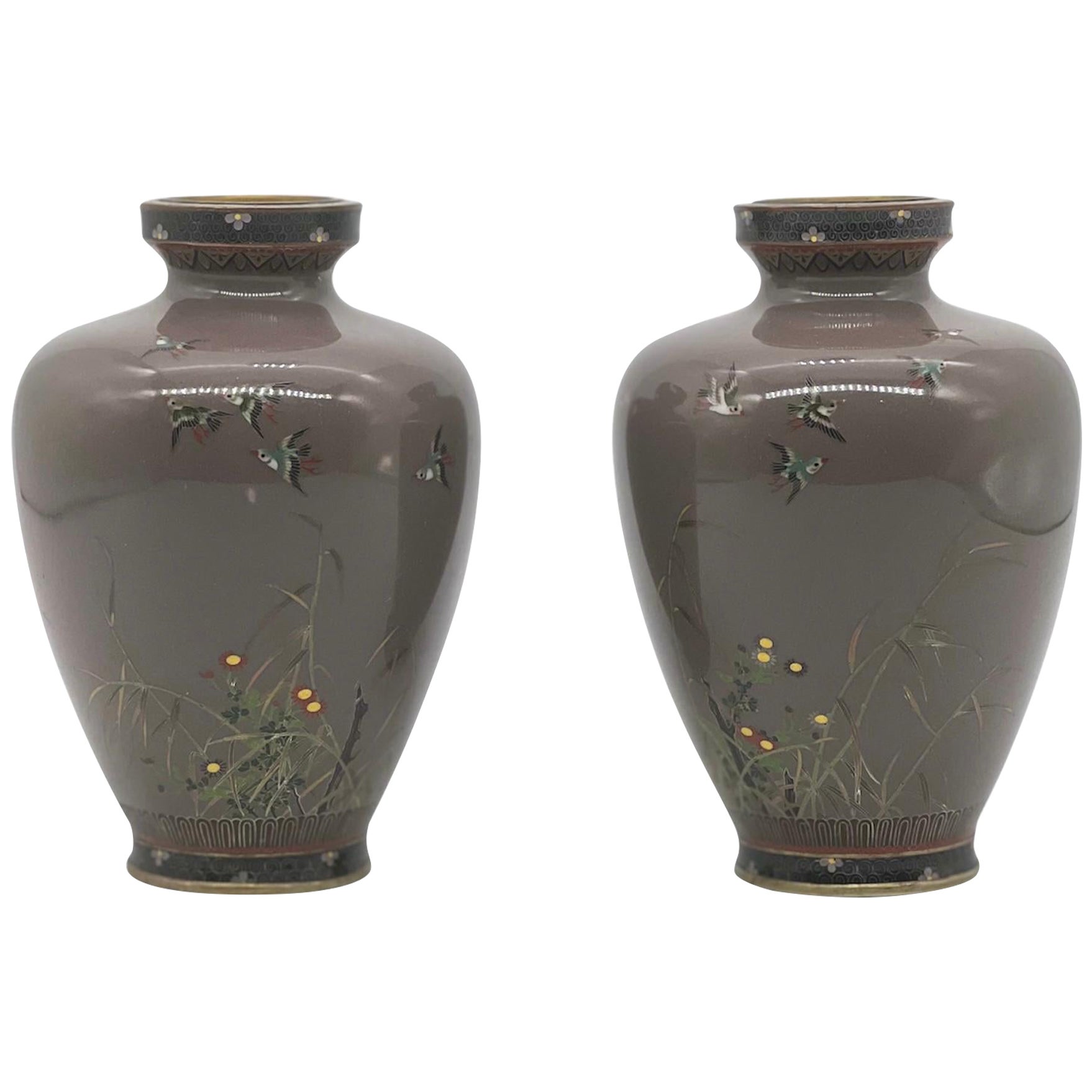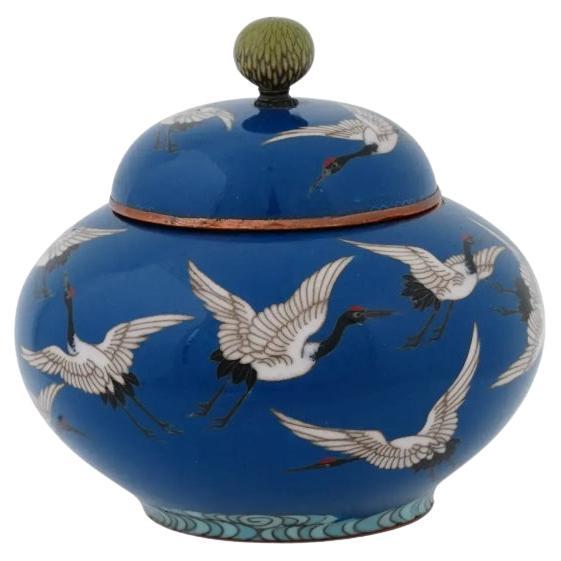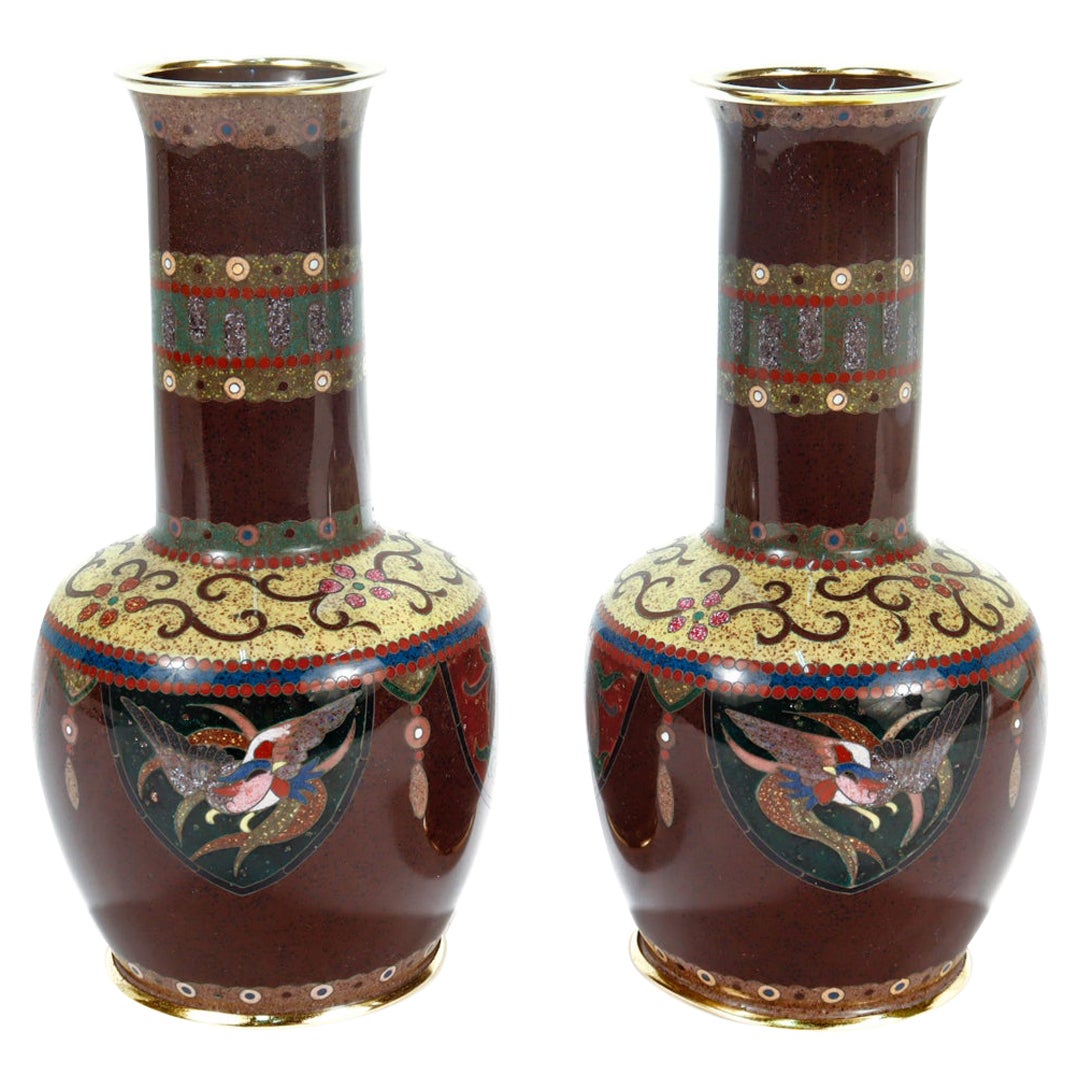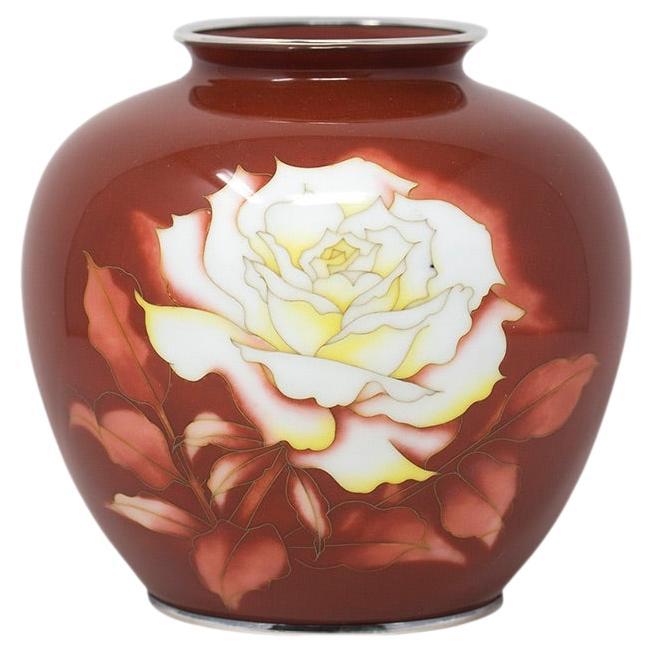Items Similar to Antique Japanese Cloisonne Enamel Vase Pair Hayashi School
Want more images or videos?
Request additional images or videos from the seller
1 of 21
Antique Japanese Cloisonne Enamel Vase Pair Hayashi School
About the Item
Meiji Period (1868-1912)
From our Japanese collection, we are delighted to offer this pair of Antique Japanese Cloisonne Enamel Vases by the Hayashi School in their Original Tomobako. The vases beautifully shaped with waisted hexagonal bodies, tapered necks and rounded top rims decorated upon a dark blue almost black glaze with opposing dragons. The dragons finely worked in varying gauge silver wire with visible scales and long tendrils coming from the nose. The pair enamelled with various colours really elevating the three dimensional look across the body of the vase. One vase bares the original sales label to the side while the bases are stamped with the makers mark for Hayashi School and the original cataloguing number sticker on one vase. Both vases are finished with silvered rims. The vases are accompanied by the original silk lined Tomobako with a single partition and cushioned interior for housing the vases. The exterior of the box is signed 七宝家 林製 (shippo studio, Hayashi made) with the Takahara & Co retailers logo showing that the vases were made in the Hayashi school and then retailed through Takahara & Co. The Vases date to the Meiji Period (1868-1912) circa 1900.
Takahara & Co were located in Kyoto and a known manufacturer and retailer of shippo-yaki (cloisonne). There company mark contains two mountains crossing over which looks like a stylised capital M.
Hayashi Kodenji was a student to Hayashi Shogoro (1835-1896) who played a pivotal role in training students in the art of cloisonne was a central figure in the cloisonné enamel industry well into the 20th century. Kodenji was the founder and head of the Shipo-cho enamelers guild and in 1894 he opened a school to train cloisonne workers that operated until 1907. He ran a showroom in Nagoya from 1907-1914 and also operated a sales branch in London. As a master of cloisonne wears he went on to win medals at expositions in Nuremberg 1885, Chicago 1893, Paris 1889 and St. Louis 1904 and finally a price at the Liege in 1905. He was awarded the Medal of the Green Ribbon in Japan (Ryokujuhosho) in 1902. Kodenji I went onto produce cloisonne wears with his son Suguemon (1859-1922) known as Kodenji II with virtually no easy distinction between either maker. They were both followed by Hayashi Tomijiro, Kodenji III (1879-1944) and Kurakichi Kodenji IV, (1904-1982).
Cloisonne is a technique of decorating metalwork objects with coloured material separated by wire often made from precious metals. In the first instance the decoration is formed by creating a stencil on the metal object by affixing wires to the surface which will be visible once the product is finished allowing the artisan to craft beautiful scenes such as blossoming flowers or mythical animals by filling in the spaces with various colours.
Enamel (vitreous enamel) also known as porcelain enamel, is a material made by fusing powdered glass to a substrate by firing, usually between 750 and 850 °C. The powder melts, flows, and then hardens to a smooth, durable vitreous coating. The word vitreous comes from the Latin vitreus, meaning “glassy”.
Meiji Period was an era of Japanese history that spanned from 1868 to 1912. It was the first half of the Empire of Japan, when the Japanese people began to build a paradigm of a modern, industrialised nation state and emergent great power, influenced by Western countries and aesthetics. As a result of radically different ideas, the changes to Japan were profound and it affected the social structure, politics, economy, military, and foreign relations across the board. The period corresponded to the reign of Emperor Meiji and was preceded by the Keio era and was succeeded by the Taisho era.
Cultural Art during the Meiji Period was of particular interest to the government and they overhauled the art export market which in turn promoted Japanese arts via various world’s fairs, beginning in Vienna at the world fair in 1873. The government heavily funded the fairs and took an active role organising how Japan’s culture was presented to the world including creating a semi-public company named Kiritsu Kosho Kaisha (First Industrial Manufacturing Company). The Kiritsu Kosho Kaisha was used to promote and commercialise exports of Japanese art and established the Hakurankai Jimukyoku (Exhibition Bureau) to maintain quality standards. For the 1876 Centennial International Exhibition in Philadelphia, the Japanese government created a Centennial Office and sent a special envoy to secure space for the 30,000 items that would be displayed. The Imperial Household also took an active interest in arts and crafts, commissioning works by select artists to be given as gifts for foreign dignitaries further emphasising the high quality and importance of Japanese art. Just before the end of the 19th century in 1890, the Teishitsu Gigeiin (Artist to the Imperial Household) system was created to recognise distinguished artists. These artists were selected for their exceptionally high quality wares and talent in their own industry. Over a period of 54 years Seventy artists were appointed, amongst these were ceramicist Makuzu Kozan and cloisonné enamel artist Namikawa Yasuyuki.
Antique a collectable object such as a piece of furniture or work of art that has a high value because of its age and quality. Objects of this nature are generally considered antique at 100 plus years of age.
Measurements (centimetres) 15.3cm High x 5.5cm Diameter
- Dimensions:Height: 6 in (15.24 cm)Diameter: 2.17 in (5.52 cm)
- Style:Meiji (Of the Period)
- Materials and Techniques:
- Place of Origin:
- Period:1900-1909
- Date of Manufacture:1900
- Condition:Wear consistent with age and use.
- Seller Location:Newark, GB
- Reference Number:
About the Seller
5.0
Vetted Seller
These experienced sellers undergo a comprehensive evaluation by our team of in-house experts.
Established in 2019
1stDibs seller since 2022
18 sales on 1stDibs
Typical response time: 3 hours
- ShippingRetrieving quote...Ships From: Newark, United Kingdom
- Return PolicyA return for this item may be initiated within 14 days of delivery.
More From This SellerView All
- Japanese Cloisonne Enamel Butterfly Vase Hayashi KodenjiLocated in Newark, EnglandJapanese Meiji period cloisonne enamel vase decorated with butterflies. The vase of wide globular shape with stepped shoul...Category
Antique Late 19th Century Japanese Meiji Metalwork
MaterialsMetal, Silver, Enamel
- Japanese Cloisonne Enamel Vase Pair Meiji PeriodLocated in Newark, EnglandA sensational pair of Japanese Meiji period Cloisonne enamel bottle vases. The vases of slender hexagonal form with trumpet opening upon a circular foot. Decorated to the highest qua...Category
Antique Late 19th Century Japanese Meiji Metalwork
MaterialsMetal, Silver
- Japanese Cloisonne Enamel Vase Ando CompanyBy Ando JubeiLocated in Newark, EnglandJapanese cloisonne enamel vase. The vase of globular form with tightly pinched neck and splayed opening decorated with a fine red ground enamel worked with wire and musen-shippo (wireless technique) with a central white rose with yellow tips surrounded by red leaves. The base signed to the centre with the Ando company mark and silver Jungin mark to the rim tashio-showa period. Notes Ando Cloisonné...Category
Mid-20th Century Japanese Meiji Metalwork
MaterialsSilver, Enamel
- Japanese Cloisonne Enamel Vase Ando CompanyBy Ando JubeiLocated in Newark, EnglandJapanese cloisonne enamel vase. The vase of ovoid form with circular opening, black enamel glaze and silver mounted rims. Boldly decorated with autumnal flowers and birds. To the top and bottom geometric patterns finish the vase. Notes Ando Cloisonné...Category
Early 20th Century Japanese Meiji Metalwork
MaterialsMetal, Silver, Enamel
- Japanese Cloisonne Enamel Peony Vase Ando CompanyBy Ando JubeiLocated in Newark, EnglandJapanese cloisonne enamel vase of large globular form, boldly decorated with a pastel green glaze surrounding florets of stylised peony flowers Tashio-early Showa period. The base signed to the centre with the Ando company mark and Jungin silver mark to the rim. Notes Ando Cloisonné...Category
20th Century Japanese Meiji Metalwork
MaterialsMetal, Silver, Enamel
- Japanese Cloisonne Enamel Chrysanthemum Vase Signed Ando CompanyBy Ando JubeiLocated in Newark, EnglandJapanese cloisonne enamel Chrysanthemum vase Tashio-early Showa period. The vase of bulbous form boldly decorated with a vivid green base enamel and...Category
Mid-20th Century Japanese Meiji Metalwork
MaterialsSilver, Enamel, Wire
You May Also Like
- A Fine Pair of Japanese Cloisonne Enamel Vases Attributed to Hayashi KodenjiLocated in London, GBA Exquisite Pair of Japanese Cloisonne Enamel Vases Attributed to Hayashi Kodenji. Meiji period 19th Century A Fine Pair of Japanese cloisonné ename...Category
Antique Late 19th Century Japanese Metalwork
MaterialsEnamel
- Meiji Japanese Cloisonne Enamel Flying Cranes Covered Jar Attributed to HayashiLocated in New York, NYAn antique Japanese Cloisonne Enamel lidded jar . Late Meiji period, Circa 1895 Rounded shape with pronounced base. Blue ground color. The piece is decorated with a crane bird motif....Category
Antique Late 19th Century Japanese Meiji Metalwork
MaterialsEnamel
- Pair of Signed Antique Japanese Cloisonne Enamel Vases by DaikichiBy Ando Shippo Ten, Kumeno Teitaro, Ando JubeiLocated in Philadelphia, PAA fine pair of Japanese Meiji period cloisonne enamel vases. By the Ohta Cloisonne workshop of Aichi Prefecture, Japan. T...Category
20th Century Japanese Meiji Metalwork
MaterialsEnamel
- Japanese Cloisonne Enamel Vase – Namikawa YasuyukiLocated in Christchurch, GBAs part of our Japanese works of art collection we are delighted to offer this striking Meiji Period 1868-1912, cloisonne enamel vase by the Imperial artist Namikawa Yasuyuki...Category
Antique 19th Century Japanese Meiji Metalwork
MaterialsSilver, Enamel
- Antique Meiji Japanese Cloisonne Enamel Geometric Brush Pot VaseLocated in New York, NYAn antique Japanese late Meiji Era cylindrical shaped enamel brush pot. Circa: late 19th century. The cylindrical form pot is enameled with polychrome medallions depicting a scene wi...Category
Antique Late 19th Century Japanese Meiji Metalwork
MaterialsEnamel
- Large Antique Meiji Japanese Cloisonne Enamel Brush Pot VaseLocated in New York, NYA large antique Japanese late Meiji Era cylindrical shaped enamel over copper brush pot. Circa: late 19th century. The cylindrical form pot is enameled with a polychrome image of gee...Category
Antique Late 19th Century Japanese Meiji Metalwork
MaterialsEnamel, Copper
Recently Viewed
View AllMore Ways To Browse
20th Century Asian Cloisonne Vases
Dark Bureau
Antique Swedish Display Cabinets
Oak Dining Suite
Oval Wood Marble Coffee Table
Brown Leather Vase
Orrefors Blue Glass Lamps
Stereo Cabinet Stereo
Putti Brass
Frank Traies
Caldwell Bronze Chandelier
Storage For Log
Vintage Dark Brown Pottery
Vintage Gold Candy Dish
Console Classic With Drawers
Writing Desks White Marble
1950s Kitchen Table And Chairs
Mahagony King Bed





